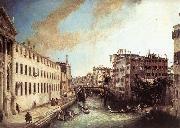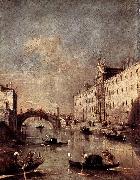
Oil On
Canvas, Real Flavor of Old Masters
|
Canaletto
|
|||
|
|
|||
| Italian Rococo Era Painter, 1697-1768 Italian painter, etcher and draughtsman. He was the most distinguished Italian view painter of the 18th century. Apart from ten years spent in England he lived in Venice, and his fame rests above all on his views (vedute) of that city; some of these are purely topographical, others include festivals or ceremonial events. He also painted imaginary views (capriccios), although the demarcation between the real and the invented is never quite clearcut: his imaginary views often include realistically depicted elements, though in unexpected surroundings, and in a sense even his Venetian vedute are imaginary. He never merely re-created reality. He was highly successful with the English, helped in this by the British connoisseur JOSEPH SMITH, whose own large collection of Canaletto works was sold to King George III in 1762. The British Royal Collection has the largest group of his paintings and drawings. | |||
|
|
|||
|
|
Rio dei Mendicanti Canaletto10.jpg Painting ID:: 5560 Visit European Gallery |
1723-24 Oil on canvas, 143 x 200 cm Museo del Settecento Veneziano, Ca' Rezzonico, Venice | |
Height Width |
INS/CM |
||
|
X |
|
||
|
|
|||
|
GUARDI, Francesco
|
|||
|
|
|||
| Italian Rococo Era Painter, 1712-ca.1793 The records of his parish in Venice show that Francesco Guardi was baptized on Oct. 5, 1712. His father, Domenico, who died when Francesco was 4, had a workshop. Francesco and his elder brother, Gian Antonio, worked in a small studio, carrying out such orders as they could get for almost anything the client wanted:mythological pictures, genre, flower pieces, battle scenes, altarpieces, and even, on rare occasions, frescoes. They did not hesitate to copy compositions by other artists, but what they borrowed they always transformed into something more capricious, less stable, more fragmentary in the refraction of light. Francesco did not emerge as an independent personality until 1760, when his brother died. Then, 48 years old, he married, established his own studio, and devoted himself chiefly to painting views of Venice. For the most part he worked in obscurity, ignored by his contemporaries. He was not even admitted to the Venetian Academy until he was 72 years old. Guardi and Canaletto have always been compared to one another because the buildings they chose to paint were often the same. But the way each artist painted them is very different. Canaletto's world is constructed out of line. It provides solid, carefully drawn, three-dimensional objects that exist within logically constructed three-dimensional space. Guardi's world is constructed out of color and light. The objects in it become weightless in the light's shimmer and dissolve in a welter of brushstrokes; the space, like the forms in space, is suggested rather than described. Canaletto belonged essentially to the Renaissance tradition that began with Giotto and, as it grew progressively tighter and more controlled, pointed the way to neoclassicism. Guardi belonged to the new baroque tradition that grew out of the late style of Titian and, as it became progressively looser and freer, pointed the way toward impressionism. Such differences appear even in Guardi's early view paintings, where he was obviously trying to copy Canaletto, such as the Basin of San Marco. The famous buildings are there, but they are far in the background, insubstantial, seeming to float. In front is a fleet of fishing boats, their curving spars seeming to dance across the surface of the canvas. What is important for Guardi is not perspective but the changing clouds and the way the light falls on the lagoon. Guardi became increasingly fascinated by the water that surrounds Venice. In late works, such as the famous Lagoon with Gondola, buildings and people have been stripped away until there is nothing but the suggestion of a thin line of distant wharfs, a few strokes to indicate one man on a gondola, a long unbroken stretch of still water, and a cloudless sky. Guardi also painted the festivals that so delighted visitors to the city, such as the Marriage of Venice to the Sea. This was a symbolic ceremony in which the doge, in the great gilded galley of the head of state, surrounded by a thousand gondolas, appeared before all Venice, in Goethe's image, "raised up like the Host in a monstrance." Of all Guardi's paintings the most evocative are his caprices, the landscapes born out of his imagination though suggested by the ruined buildings on the lonely islands of the Venetian lagoon. A gentle melancholy clings to such scenes. | |||
|
|
|||
|
|
Rio dei Mendicanti new16/GUARDI, Francesco-369566.jpg Painting ID:: 44409 Visit European Gallery |
1780 Oil on canvas, 19,5 x 15 cm | |
Height Width |
INS/CM |
||
|
X |
|
||
|
|
|||








